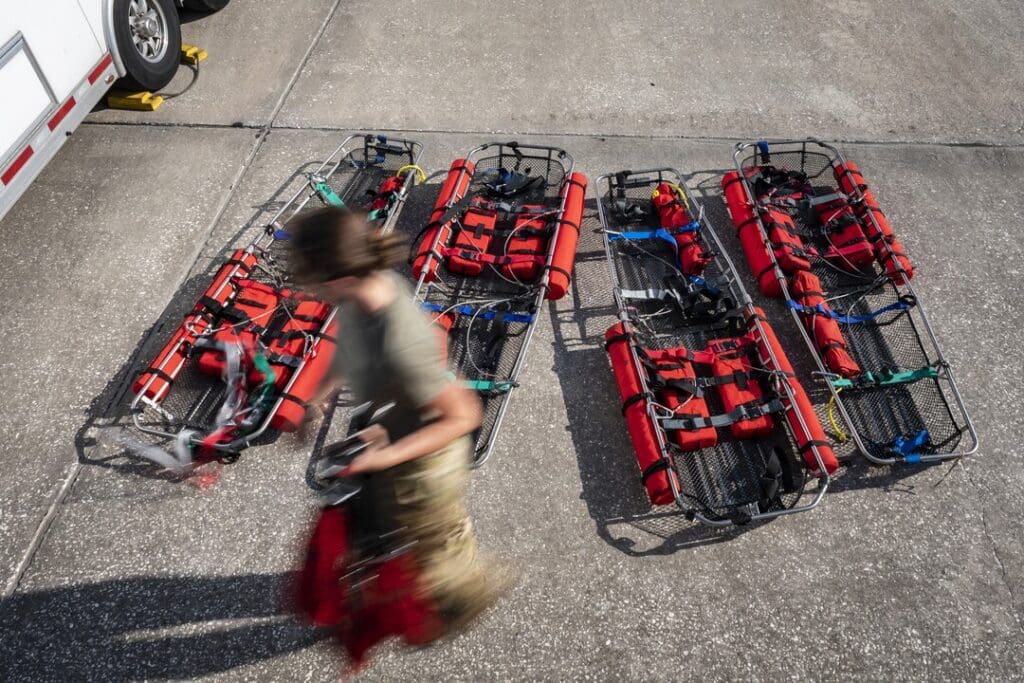
Load Testing of ALSE Gear
There is a long ingrained habit among those who use maintain helicopter rescue gear; the periodic load test. Every six months (or annually in many cases) there are rescue strops, litters, and baskets being hung from cranes all over the world to prove they are still fit for service. It seems reasonable. If someone is going to hang from their life in the thing, operators should test them, under a load, to make sure they are still good, right?
My company, LSC, has played a part in keeping that practice alive. We have historically included periodic load testing for slings, strops, litters, and other load-bearing devices, into our product owner’s manuals for decades. We’re stopping. In fact, on the current owner’s manuals for strops, Medevac Litters, Rescue Baskets, you won’t find a recommended load test. Truthfully, we’ve never really thought it was necessary, at least not since the mid 80s when the cotton-webbing kapok horse collar was replaced with a strop of more modern materials.
Here’s why:
LOAD TEST HISTORY
Load testing of products used for human external cargo in helicopter hoisting evolutions began with that original piece of primary rescue gear, the original survivor sling made from cotton webbing fitted with a kapok filled flotation pad. As the cotton would mildew and weaken, the 600 pound load test became a common practice in the U.S. Navy and U.S. Coast Guard to ensure the strength of the webbing that could not be visualized within the device.
This device was in use for decades and upon its replacement with versions made from Mil-Spec Nylon Webbing, the history of load testing was maintained out of an abundance of caution. Load testing of anything that lifts a human seemed prudent and ALSE managers in most organizations used the 500-600 LB annual or six-month load test for any piece of gear that lifts people.
LSC OWNER’S MANUALS / INSTITUTIONAL MAINTENANCE PROCEDURES
At the request of customers, primarily the U.S. Navy and U.S. Coast Guard, Lifesaving Systems Corp included the load test recommendation into our owner’s manuals as a courtesy to avoid confusion with the users whose official maintenance procedures included a load test. As LSC overbuilds (often to extremes) any product that is connected to a hoist hook) load testing any of our load bearing products simply as periodic maintenance has always been unnecessary.
As there has never been a reported failure of a periodic load test of any LSC sling, strop, litter, or compact rescue basket, in the history of use within the U.S. Navy and Coast Guard, LSC has removed the recommendation for periodic load testing from its manufacturer’s minimum recommended maintenance procedures for the products listed below.
(Given the design strength of these products, there is nothing about hanging weights equal to less than 10% of their load limits that will provide any useful information to inspectors.)
• The Survivor’s Sling (LSC Part# 216) will take loads up to 7,000 pounds before breaking.
• Quick Strops (LSC Part# 214 (series)) when lifted in a loop with both rings active will take loads up to 10,000 pounds without breaking
• 190 to 193 (Series) litter slings will take loads up to 9,000 LBS without breaking (all four legs engaged).
• 499 and 495 Rescue Baskets will deform over 1,500 LBS but have been tested with 3,000 LBS of load and did not mechanically fail. It is estimated that breaking the connection to the hoist hook would require loads exceeding 10,000 LBS.
• 404-406 (series) MEDEVAC II litters have been tested to 3,000 LBS without deformation. It is estimated that breaking the connection to the hoist hook would require loads exceeding 9,000 LBS.
The hoist cable of the most aircraft will part at 3,900 pounds max.
LSC RECOMMENDATIONS
LSC Recommends that all ALSE maintenance organizations refer to LSC owner’s manuals at support.lifesavingsystems.com for cautions and warning and for minimum recommended inspection and maintenance practices.
LSC recommends if there is any suspected unseen damage to a load bearing product (i.e., following a shock load) that the product be replaced. Taking a product designed to hold 5,000 pounds and pulling it for 15 minutes to 600 pounds will not provide inspectors with any useful information about its condition. Thorough visual inspections will. If there is suspected damage, criteria for those inspections is available on our product support website.
LSC recommends that units do not exceed the service life set for products and that regular documented visual inspections (in accordance with our owner’s manuals) are the best way to determine a products suitability for service.
Are you still load-testing your hoist equipment? Contact LSC at products@lifesavingsystems.com for clarity regarding our recommendations and owner’s manuals.

